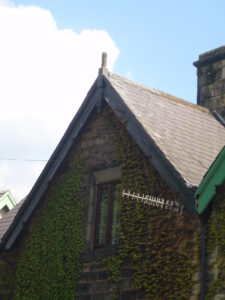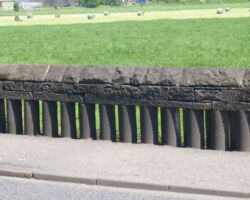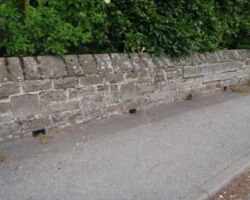Darley Dale often simply known as Darley (but not to be mistaken for the Darley near Derby), grew in the 19th and 20th centuries around the lead mining, metal forging, railway and quarrying industries.
The name Darley is derived from the Old English deor-leah or ‘the place frequented by deer’.
Recorded as Dereleie in 1086, Derleia in 1125 and Derlega in 1155. The Saxon deor is used to mean ‘animals’ as well as specifically ‘deer’.
‘Land of King William
Households: 7 villagers. 1 priest.
Land and resources –
Ploughland: 3 ploughlands. 1 lord’s plough teams. 3 men’s plough teams.
Other resources: Meadow 12 acres. Woodland 2 * 2 leagues. 1 church.
Valuation – Annual value to lord: 4 pounds in 1086; 2 pounds in 1066.’
St Helens Church in Darley Dale dates from the 12th century and contains monuments to Sir John de Darley who was Lord of the Manor over 600 years ago and one of the oldest trees in the country is the famous yew in St Helen’s churchyard at Darley Dale, estimated to be 2,000 years old.
Outbreaks of plague and smallpox broke out at Darley Dale in the 16th/17th centuries. “Ye sweatinge sickness” claimed nine lives in six days.
Church Lane at Darley Dale was known as Ghost Lane in 1635 after a Scottish pedlar was murdered there. Ghost stories about murdered Scottish pedlars come from Darley Dale, Hayfield and Eyam wakes. Pedlars tended to be called Scottish only because they sold cheap Scottish linen.
Darley Dale Hydropathic Establishment was offering the Mild Water Cure. Set in 50 acres of wooded parkland the hydro was promoted as ‘A great sanatorium, a noted pleasure resort, one of the most agreeable summer or winter holiday retreats … [with] … Tennis! Billiards! Golf! Fishing!’. Probably the last ice house to be built locally was constructed around 1890 at the new Darley Dale Hydro.
The Hydro was also run like a high-class hotel, sumptuously furnished and with every convenience from stables to an ice house but the owner went bankrupt. In 1904 the empty property was taken over as St Elphin’s school which is where Richmal Crompton was educated.
Public transport relied on the horse for many more years. Two Dales blacksmith Arthur Watts charged three pence (1.5p) for a journey to Matlock in his horse-drawn brake. James Smith, a nursery owner from Darley Dale, later ran the Primrose Bus at weekends. This was really his tree delivery lorry, freshly washed out and fitted with yellow seats.
A lone sycamore on Oker Hill, Darley Dale, was the inspiration for a sonnet composed in 1838 by William Wordsworth. In The Keepsake, he relates how two brothers each planted a sycamore on the summit of the hill before parting to make their way in the world. One brother became successful and his tree thrived, the other met misfortune and an early death – and his tree died.
To protect millstones during transit heather was packed around them. Also in the first half of the 20th century it was grown at Darley Dale nurseries especially for packing iron tubes and other goods. Large quantities of heather were sent in railway wagons from Darley station to Stanton Iron Works near Chesterfield.
From the 19th century, one of the largest nursery owners in Derbyshire was James Smith & Sons. In Victorian times they had nine nurseries at Darley Dale with many thousands of trees, but the firm was particularly proud of its one million rhododendrons and “flowers of every clime – from Indus to the Pole”.
Rhododendrons were particularly popular. After their first introduction to gardens from Turkey in 1763 they were planted extensively in the smartest gardens and estates. A reporter from the High Peak News informed readers in May 1899 that the rhododendrons were in full bloom in the pleasure gardens of Stancliffe Hall at Darley Dale, where “some of the finest rock gardens in the kingdom” were newly open to the public. The Hall had until recently been owned by Lady Whitworth, widow of Sir Joseph the great inventor.
Joseph Whitworth moved into Stancliffe Hall, Darley Dale in 1871 with his second wife Mary Louisa Orrell. Sir Joseph apparently planned many things for Darley Dale but carried out comparatively few. In addition to constructing new roads he built a number of cottages for his estate workers. The estate was a major source of employment for local people both in the house, on the land and in the quarry situated near to the house. Stone from the quarry was used in many local buildings including the staircase in the Painted Hall at Chatsworth House. Stancliffe stone also provided the paving stones for Trafalgar Square and the plinth of the Victoria and Albert monument.
Whitworth had a number of stone houses built on Church Road and Green Lane, their gables topped with wooden replicas of the shells fired by his famous cannon. Over time, these wooden shells have rotted away, leaving the remnants of just one survivor on Church Road in 2009.
Dr Wrench from Baslow qualified as a Member of the Royal College of Surgeons (MRCS) in 1870 and was Consulting Surgeon to the Whitworth Hospital, Darley Dale.
A unique ‘disc’ engine in the form of simple turbine was patented by the Dakeyne Brothers in 1830 who were flax millers at Darley Dale.
Johnson’s cattle-feed mill at Darley Dale was taken over for war production by Bakelite, who moved out of Birmingham to escape the blitz. Bakelite produced materials for armaments, including Mosquito aeroplanes. Most bomber and fighter aircraft had Bakelite insulation and control panels.
This unusual wall at Darley Dale is made from the cores of pulp roller millstones. It is thought to have been built with these to allow flood water to easily drain from the road.
Cores have been used in a cottage porch at Birchover and pulp millstones can be seen built into a wall at Old Engine Farm.
Other walls nearby are designed to allow flood water through.







